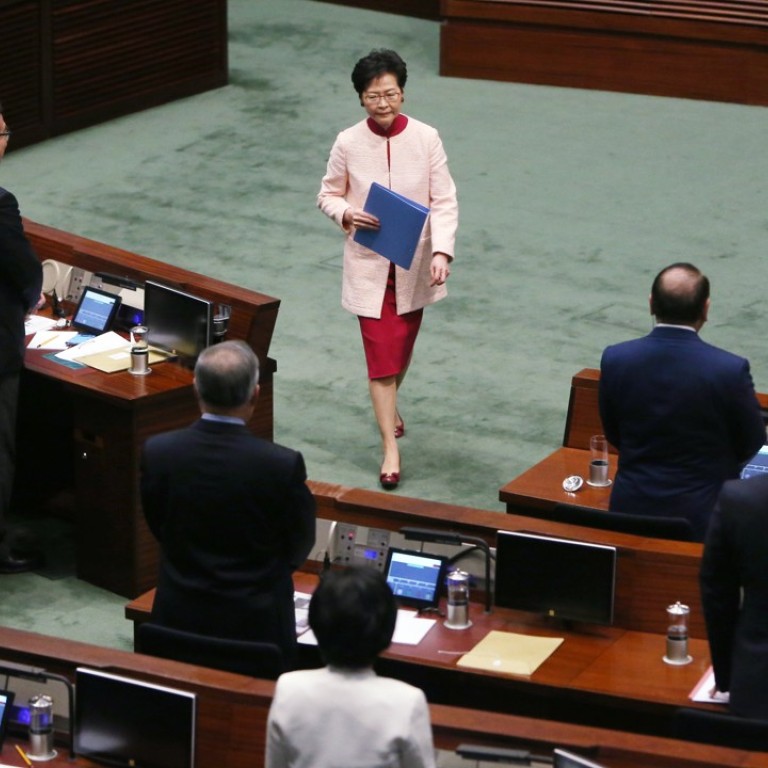
‘Decisive’ Carrie Lam pushes ahead with controversial housing, land supply and social initiatives in her second Hong Kong policy address
City leader says she is not afraid to tackle issues left unresolved by predecessors as she offers solutions in her policy blueprint
Hong Kong’s leader was out to demonstrate her “decisive” style of governance on Wednesday as she unveiled a policy blueprint proposing to push ahead with controversial housing, land supply and social initiatives that her predecessors had left unresolved after divisive public debate.

“This policy address carries my unswerving determination in leading Hong Kong to strive forward. While there are many words, they serve just one purpose: rekindling hope for Hong Kong,” Lam said.
The blueprint, titled “Striving Ahead, Rekindling Hope”, also featured initiatives ranging from lengthening maternity leave to 14 weeks and phasing out diesel commercial vehicles to bolstering the maritime and IT sectors as new driving forces of Hong Kong’s growth.
Five key takeaways from Carrie Lam’s policy address
While they were forcibly removed or walked out of the chamber, Lam went on to promise she would protect national security and “fearlessly take actions against” anyone seeking to separate the city from China and threaten the country’s sovereignty and territorial integrity.
Lam’s policy blueprint was generally welcomed by business chambers, social welfare groups and pro-establishment lawmakers, who praised the chief executive for demonstrating courage in addressing the city’s deep-rooted problems.
However, green groups and the pan-democratic legislators questioned the merits and cost of her land reclamation schemes, with the latter also doubting Lam’s commitment to protecting the city’s civil liberties.
In a survey by the University of Hong Kong’s public opinion programme on Wednesday, 33 per cent of respondents were satisfied with the policy address, down from last year’s 48 per cent, while 34 per cent were not, compared with 14 per cent last year.
Hong Kong leader sets out public-private sector ‘land sharing’ scheme
Since taking office as the chief executive in July last year, she said, she had come to realise “the government should act swiftly and boldly on matters which clearly serve the public interest”.

In that spirit, she proposed setting aside 70 per cent of newly developed land for public and subsidised housing. She also hinted at increasing the ratio of public to private housing from 6:4 to 7:3 when the Long Term Housing Strategy is reviewed.
A showpiece of Lam’s land supply and housing solution will be the massive new project dubbed “Lantau Tomorrow Vision”, which will see the creation of a new metropolis spanning about 1,700 hectares, including a group of artificial islands to the east of Lantau.
It plans to provide up to 400,000 residential flats, 70 per cent of which will be reserved for public housing, and accommodate up to 1.1 million people in the next 20 to 30 years.
Lam’s future vision is a HK$500 billion housing development in sea
With the megaproject estimated to cost as much as HK$500 billion, Lam faced a barrage of questions as to whether she was being overambitious and willing to use up to half the city’s fiscal reserves.
“It’s really, in my view, quite narrow-minded to try to avoid doing things because it is expensive,” she replied. “I could go for the populist route and not do this sort of controversial things, but that’s not good for the people, especially the younger generation who want to see hope in living in Hong Kong.”
On top of the HK$50 billion (US$6.3 billion) earmarked for innovation in the government’s budget, another HK$28 billion (US$3.6 billion) would be set aside for research and development in universities and re-industrialisation, she said.
Subsidies to lure young entrepreneurs to ‘Greater Bay Area’
In a statement, Hong Kong General Chamber of Commerce chairman Aron Harilela praised Lam for addressing “the difficulties facing Hong Kong head-on with concrete proposals”.
“We are particularly pleased to see the injection of an additional HK$28 billion of funding in areas including university research and re-industrialisation,” he said.
Lam listed “three beliefs”: belief in her own ability to build a better city; belief that Hongkongers would seize development opportunities offered by Beijing; and belief in the nation’s support.
“Any problems can be solved,” was how Lam summed up her philosophy at a media panel discussion in the evening. “In this policy address, we try to roll out solutions that had been left undealt with in the past.”


